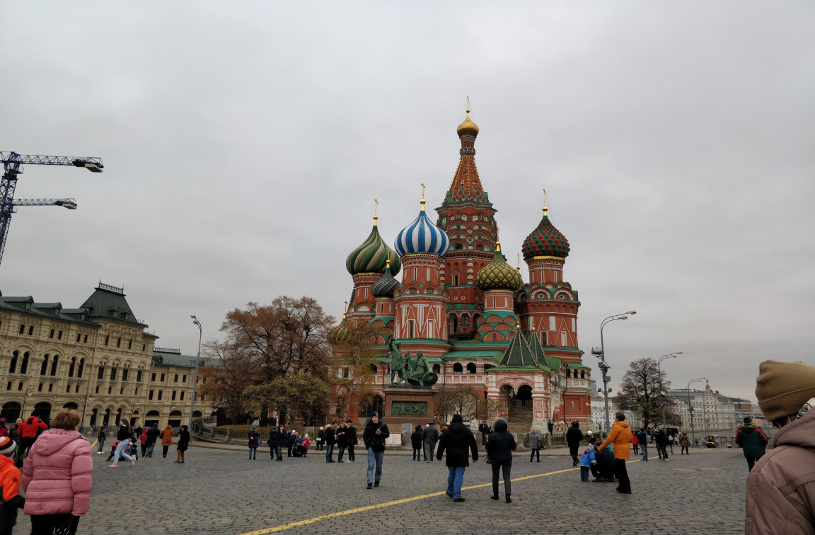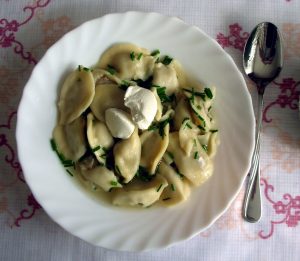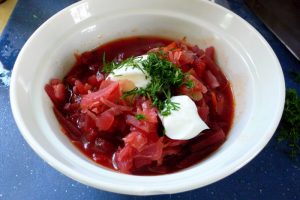The beautiful country of Russia isn’t exactly known for its cuisine aside from borscht, caviar or dumplings with a side of vodka. However, in our many years of travelling and running adventure tours through this vast , varied and fascinating country, YPT guides have encountered some amazing Russian food!
It may come as a surprise that, for the biggest country in the world, the same types of classic cuisine can be found in almost all corners of Russia – borscht, caviar and pelmeni which can be purchased anywhere. However of course each region also has its own speciality of Russian food. For example, Siberia is well renowned as the birthplace of classic Pelmeni and North Caucasus republics such as Chechnya and Dagestan are famous for their Shashlik kebabs, cheese and pumpkin-based dishes.
In a country as big as Russia, it may be a daunting task knowing where to start first with its cuisine, so we hope this guide will assist you in ordering the best foods and keeping a full stomach across the country.
Table of Contents

Russian Cuisine
To begin, the first obstacle is the language barrier as many cheap and delicious places in Russia do not have English speaking staff or menus, or if they do have an English menu it is usually bizarrely translated. This can be very off-putting to travellers. One way to avoid this is by visiting a type of restaurant called ‘stolovaya’, which translates to ‘canteen’. This is a Soviet system which basically gives you an enormous buffet of fresh Russian food. You simply point at what you want then pay for it at the end of the line – a very simple system which gives you access to usually great quality, cheap food – a great option for cheap travel. But if you want to try out a restaurant without an English menu then take your time, try to pick up some Cyrillic alphabet and know some keywords:
Samsa
Russian type of samosa originating from Central Asia and introduced during Mongol invasions centuries ago. Usually filled with assortments of cabbage, potatoes, meat or sometimes pumpkin and cottage cheese. Just think ‘samosa’ with a Russian accent.
Pelmeni
The Russian version of ravioli or pierogi which can contain numerous combinations of ingredients topped with a sauce of some kind. They originated in Siberia where they were usually made in enormous amounts in Russian villages and stored during winter where they were frozen and preserved. When they were needed to be eaten the villagers would simply need to throw them in boiling water for 15 minutes and finish up with a side of fresh sour cream or smetana. This simple but hearty dish kept Russian peasant workers going for centuries.
Smetana
The Russian word for sour cream. Now if you’re like me, you’re obsessed with sour cream. This makes a great addition to almost every Russian food, but sometimes needs to be requested. Think of it as the ‘cement’ of the meal which binds everything together. In my opinion, the foods which go best with sour cream are borscht dunked into the middle of the soup turning it a pink colour, then thrown over the top of a bowl of pelmeni.
Blini
A favourite Russian food which can be served with different jams, cottage cheese, chocolate, caviar and of course, sour cream. They can be found nearly everywhere and are cheap and quick if you’re in a rush. The best part is, depending on the filling, they can be eaten as breakfast, lunch, dinner and are also a great example of a Russian dessert.
Shashlik
Stemming from the Islamic influence from surrounding nations, this is Russia’s answer to a shish kebab. Marinated in spices and served with a bit of flat bread, fresh onions and sauce, it’s definitely a must try for meat lovers. The best shashlik I’ve ever tasted was in Derbent, Dagestan in the North Caucasus – where the lamb fell off the stick with just a tap of the fork. Closer to Iran than Moscow, this is arguably where the shashlik originated before spreading across Russia.
Borscht (The most famous Russian food?)
Now for Russians and anyone who’s taken the Trans-Siberian, borscht is life. Simple and like blini, found everywhere. Always cheap, always reliable and served with a dollop of sour cream – what’s not to love? A warm and welcome friend during the Russian winters, cooking styles of this dish can vary so don’t be put off if the first borscht you try isn’t to your liking.
Medaliony
The Russian word for medallions, found in many restaurants and usually made from pork, these can be served with roasted vegetables and a great sauce. Perfect for a main meal. They may look small but don’t be fooled; these things fill you up fast so don’t over-order!
Zaguday
This is perfect as a starter or when having some friendly vodka shots and you need a chaser. Zaguday is a seafood lovers’ dream – a dish featuring plenty of fish. Its main ingredients are raw fresh fish with olive oil, onions and a bit of pepper. Absolutely amazing and is perfect with everyone’s favourite alcoholic potato juice.
Piva
Beer. When you order a beer in Russia you will be offered the brand name and if you want light (as in colour not alcohol content) or dark. Light is known as svetloye and dark is called temnoye. Every time I crave a beer I simply say piva svetlyoe (in an atrocious accent) and it gets the job done eventually.
Zherenoe
This is the Russian word for fried. Super useful to know as there are many things like kartofle zherenoe (French fries), or my favourite sir zherenoe (fried cheese).
Russian Mannerisms
Secondly, people working in restaurants in Russia can sometimes be very intimidating. I personally have experienced what seemed like a scolding from an old Russian babushka because I was taking too long to figure out the menu. When this happens, relax, and try not to be offended. Remember she is the boss and you won’t win – be warm towards her and she will guide you through your culinary excursion of Russian food.
Key Survival Phrases for travelling through Russia:
Russians have a bad reputation for being rude and hostile to travellers, if you don’t attempt to speak a word of Russian, then yes, they will be. However, manners in Russia go a very long way. Learn very basic and fairly simple phrases such as ‘hello’, ‘can I have’, ‘please’, ‘thank you’ and ‘goodbye’ and you will see how friendly Russians can be. The locals truly change their attitude towards foreigners who attempt to speak their language (no matter how good or bad you speak it, as long as you try!). The following words and phrases are spelled out for easy pronunciation for first time Russian speakers:
Zdrasvitcha – pronounced as ‘zrdras-vit-cha’. It is a formal and polite way of saying hello to people you do not know.
Privyet – pronounced ‘priv-yet’. Translates roughly as ‘hey’. It is informal and reserved for people you have met before.
Mozshna – pronounced as ‘moz-shna’. It translates to ‘may I have’, ‘can I’ or ‘is it possible’ etc. It is a very important and polite phrase that allows you to navigate through many travel scenarios in Russian speaking countries. For trying to get past someone to ask for something in a store or restaurant, this word is your friend.
Spasiba – pronounced as ‘spa-si-ba’. This simply translates to ‘thank you’ and will be much appreciated from locals if they need to be thanked for something.
Pozhalusta – pronounced as ‘poz-hal-usta’ – this word translates to ‘please’ (seems like a very long word for such a word but trust us – this word is golden).
Dosvidanya – pronounced as ‘dos-vid-anya’. This translates to ‘goodbye’ and is a polite way to bid farewell to Russians.








